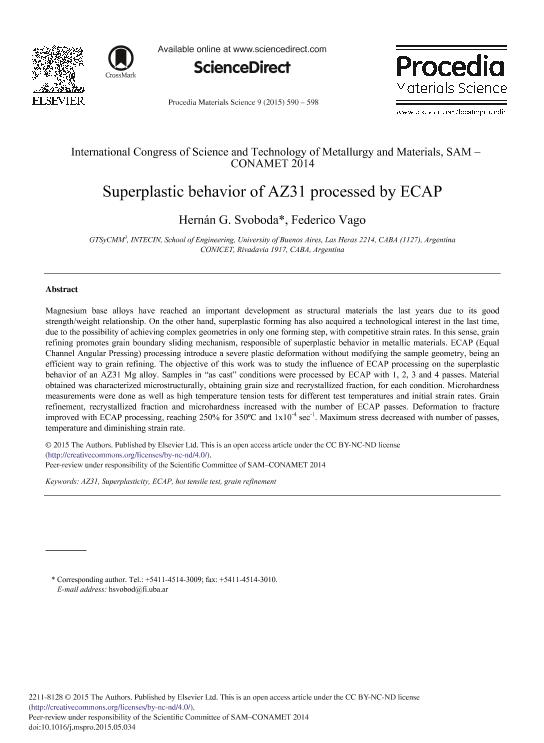Artículo
Superplastic behavior of AZ31 processed by ECAP
Fecha de publicación:
09/2015
Editorial:
Elsevier
Revista:
Procedia Materials Science
ISSN:
2211-8128
Idioma:
Inglés
Tipo de recurso:
Artículo publicado
Clasificación temática:
Resumen
Magnesium base alloys have reached an important development as structural materials the last years due to its good strength/weight relationship. On the other hand, superplastic forming has also acquired a technological interest in the last time, due to the possibility of achieving complex geometries in only one forming step, with competitive strain rates. In this sense, grain refining promotes grain boundary sliding mechanism, responsible of superplastic behavior in metallic materials. ECAP (Equal Channel Angular Pressing) processing introduce a severe plastic deformation without modifying the sample geometry, being an efficient way to grain refining. The objective of this work was to study the influence of ECAP processing on the superplastic behavior of an AZ31 Mg alloy. Samples in “as cast” conditions were processed by ECAP with 1, 2, 3 and 4 passes. Material obtained was characterized microstructurally, obtaining grain size and recrystallized fraction, for each condition. Microhardness measurements were done as well as high temperature tension tests for different test temperatures and initial strain rates. Grain refinement, recrystallized fraction and microhardness increased with the number of ECAP passes. Deformation to fracture improved with ECAP processing, reaching 250% for 350 °C and 1x10-4 sec-1. Maximum stress decreased with number of passes, temperature and diminishing strain rate.
Palabras clave:
Az31
,
Superplasticity
,
Ecap
,
Hot Tensile Test
,
Grain Refinement
Archivos asociados
Licencia
Identificadores
Colecciones
Articulos(INTECIN)
Articulos de INST.D/TEC.Y CS.DE LA ING."HILARIO FERNANDEZ LONG"
Articulos de INST.D/TEC.Y CS.DE LA ING."HILARIO FERNANDEZ LONG"
Citación
Svoboda, Hernán Gabriel; Vago, Federico; Superplastic behavior of AZ31 processed by ECAP; Elsevier; Procedia Materials Science; 9; 9-2015; 590-598
Compartir
Altmétricas




